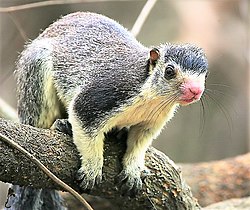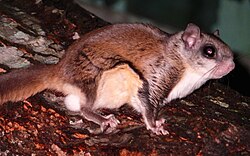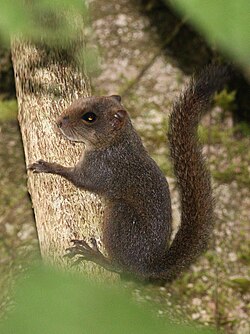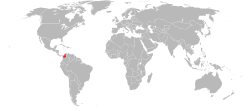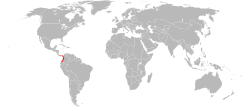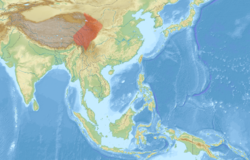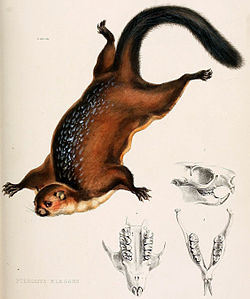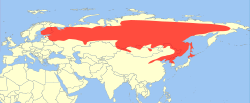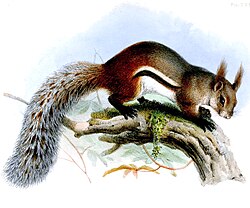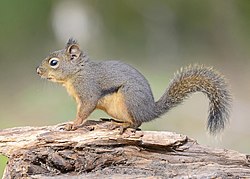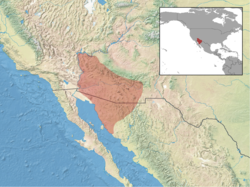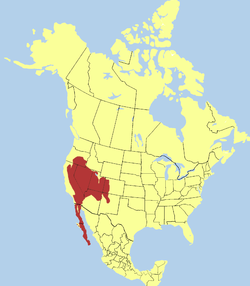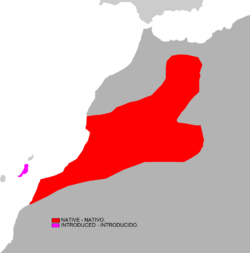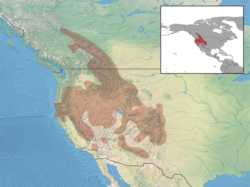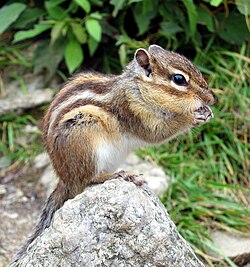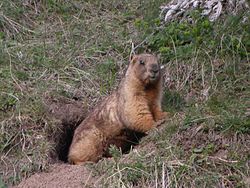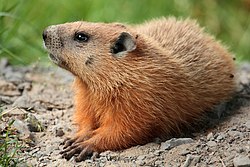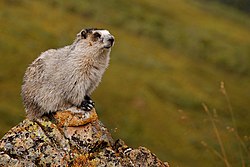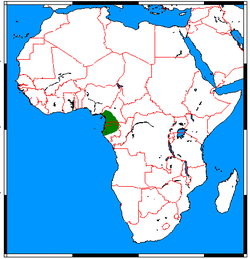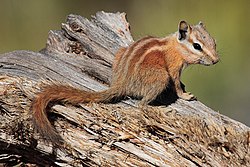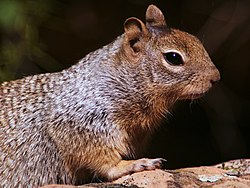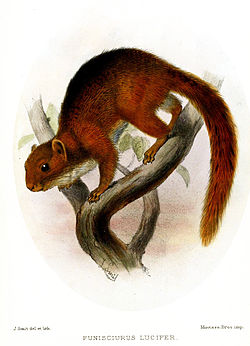| Common name | Scientific name and subspecies | Range | Size and ecology | IUCN status and estimated population |
|---|
| Abert's squirrel 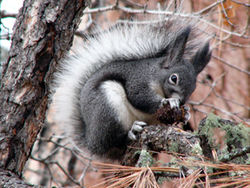 | S. aberti
Woodhouse, 1853
- S. a. aberti
- S. a. barberi
- S. a. chuscensis
- S. a. durangi
- S. a. ferreus
- S. a. kaibabensis (Kaibab squirrel)
| Western United States and western Mexico
 | Size: 26–27 cm (10–11 in) long, plus 21–22 cm (8–9 in) tail [146]
Habitat: Forest [147]
Diet: Nuts, seeds, fruit, buds, and tree shoots [148] | LC
Unknown  [147] [147]
|
|---|
| Allen's squirrel  | S. alleni
Nelson, 1898 | Mexico
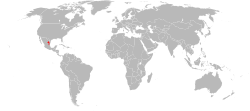 | Size: 22–25 cm (9–10 in) long, plus 22–25 cm (9–10 in) tail [146]
Habitat: Forest [149]
Diet: Nuts, seeds, fruit, buds, and tree shoots [148] | LC
Unknown  [149] [149]
|
|---|
| Andean squirrel 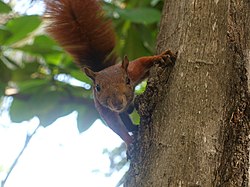 | S. pucheranii
(Fitzinger, 1867)
- S. p. caucensis
- S. p. medellinensis
- S. p. pucheranii
| Northwestern South America
 | Size: 14–19 cm (6–7 in) long, plus 11–16 cm (4–6 in) tail [97]
Habitat: Forest [150]
Diet: Nuts, seeds, fruit, buds, and tree shoots [148] | DD
Unknown  [150] [150]
|
|---|
| Arizona gray squirrel 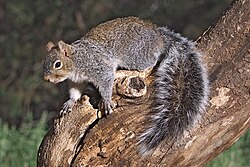 | S. arizonensis
Coues, 1867
- S. a. arizonensis
- S. a. catalinae
- S. a. huachuca
| Western United States and western Mexico
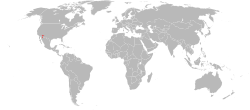 | Size: 25–26 cm (10 in) long, plus about 25 cm (10 in) tail [146]
Habitat: Forest, shrubland, and grassland [151]
Diet: Nuts, seeds, fruit, buds, and tree shoots [148] | DD
Unknown  [151] [151]
|
|---|
| Bolivian squirrel  | S. ignitus
(Gray, 1867)
- S. i. argentinius
- S. i. boliviensis
- S. i. cabrerai
- S. i. ignitus
- S. i. irroratus
| Western South America
 | Size: 14–22 cm (6–9 in) long, plus 15–23 cm (6–9 in) tail [97]
Habitat: Forest [152]
Diet: Nuts, seeds, fruit, buds, and tree shoots [148] | LC
Unknown  [152] [152]
|
|---|
| Brazilian squirrel 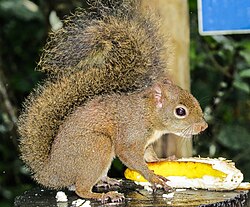 | S. aestuans
Linnaeus, 1766
- S. a. aestuans
- S. a. alphonsei
- S. a. garbei
- S. a. georgihernandezi
- S. a. henseli
- S. a. ingrami
- S. a. macconnelli
- S. a. poaiae
- S. a. quelchii
- S. a. venustus
| South America
 | Size: 16–19 cm (6–7 in) long, plus 16–25 cm (6–10 in) tail [97]
Habitat: Forest [153]
Diet: Nuts, seeds, fruit, buds, and tree shoots [148] | LC
Unknown  [153] [153]
|
|---|
| Calabrian black squirrel 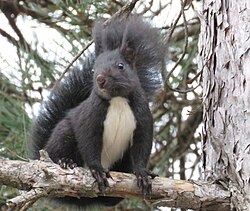 | S. meridionalis
Lucifero, 1907 | Southern Italy
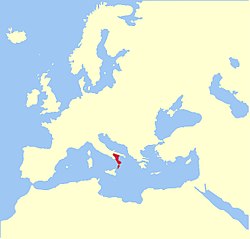 | Size: Unknown [146]
Habitat: Forest [154]
Diet: Nuts, seeds, fruit, buds, and tree shoots [148] | NT
Unknown  [154] [154]
|
|---|
| Caucasian squirrel  | S. anomalus
Gmelin, 1778
- S. a. anomalus
- S. a. pallescens
- S. a. syriacus
| Western Asia
 | Size: 19–25 cm (7–10 in) long, plus 12–17 cm (5–7 in) tail [146]
Habitat: Forest [155]
Diet: Nuts, seeds, fruit, buds, and tree shoots [148] | LC
Unknown  [155] [155]
|
|---|
| Collie's squirrel  | S. colliaei
Richardson, 1839
- S. c. colliaei
- S. c. nuchalis
- S. c. sinaloensis
- S. c. truei
| Western Mexico
 | Size: 24–25 cm (9–10 in) long, plus 24–26 cm (9–10 in) tail [146]
Habitat: Forest [156]
Diet: Nuts, seeds, fruit, buds, and tree shoots [148] | LC
Unknown  [156] [156]
|
|---|
| Deppe's squirrel 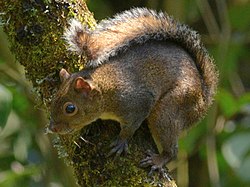 | S. deppei
Peters, 1863
- S. d. deppei
- S. d. matagalpae
- S. d. miravallensis
- S. d. negligens
- S. d. vivax
| Southern Mexico and Central America
 | Size: About 21 cm (8 in) long, plus 17–18 cm (7 in) tail [97]
Habitat: Forest [157]
Diet: Nuts, seeds, fruit, buds, and tree shoots [148] | LC
Unknown  [157] [157]
|
|---|
| Eastern gray squirrel  | S. carolinensis
Gmelin, 1788
- S. c. carolinensis (Carolina gray squirrel)
- S. c. extimus (Florida gray squirrel)
- S. c. fuliginosus (Louisiana gray squirrel)
- S. c. hypophaeus (Merriam's gray squirrel)
- S. c. pennsylvanicus (Pennsylvania gray squirrel)
| Canada and eastern United States
 | Size: 20–31 cm (8–12 in) long, plus 15–25 cm (6–10 in) tail [146]
Habitat: Forest [158]
Diet: Nuts, seeds, fruit, buds, and tree shoots [148] | LC
Unknown  [158] [158]
|
|---|
| Fiery squirrel
| S. flammifer
Thomas, 1904 | Venezuela
 | Size: 27–30 cm (11–12 in) long, plus 24–31 cm (9–12 in) tail [97]
Habitat: Forest [159]
Diet: Nuts, seeds, fruit, buds, and tree shoots [148] | DD
Unknown  [159] [159]
|
|---|
| Fox squirrel  | S. niger
Linnaeus, 1758
- S. n. avicinnia (Mangrove fox squirrel)
- S. n. bachmani (Upland fox squirrel)
- S. n. cinereus (Delmarva fox squirrel)
- S. n. limitis (Texas fox squirrel)
- S. n. ludovicianus (Pineywoods fox squirrel)
- S. n. niger (Southern fox squirrel)
- S. n. rufiventer (Western fox squirrel)
- S. n. shermani (Sherman's fox squirrel)
- S. n. subauratus (Delta fox squirrel)
- S. n. vulpinus (Eastern fox squirrel)
| Canada and United States
 | Size: 26–37 cm (10–15 in) long, plus 20–33 cm (8–13 in) tail [146]
Habitat: Forest [160]
Diet: Nuts, seeds, fruit, buds, and tree shoots [148] | LC
Unknown  [160] [160]
|
|---|
| Guayaquil squirrel 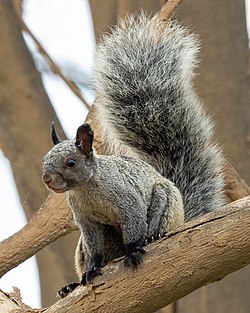 | S. stramineus
Eydoux & Souleyet, 1841 | Ecuador and Peru
 | Size: 18–32 cm (7–13 in) long, plus 25–33 cm (10–13 in) tail [97]
Habitat: Forest [161]
Diet: Nuts, seeds, fruit, buds, and tree shoots [148] | LC
Unknown  [161] [161]
|
|---|
| Japanese squirrel  | S. lis
Temminck, 1844 | Japan
 | Size: 16–22 cm (6–9 in) long, plus 13–17 cm (5–7 in) tail [146]
Habitat: Forest [162]
Diet: Nuts, seeds, fruit, buds, and tree shoots [148] | LC
Unknown  [162] [162]
|
|---|
| Junín red squirrel 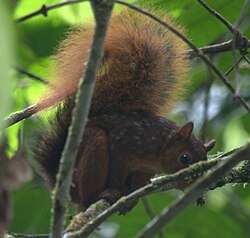 | S. pyrrhinus
Thomas, 1898 | Ecuador and Peru
 | Size: 24–25 cm (9–10 in) long, plus 21–25 cm (8–10 in) tail [97]
Habitat: Forest [163]
Diet: Nuts, seeds, fruit, buds, and tree shoots [148] | DD
Unknown  [163] [163]
|
|---|
| Mexican fox squirrel 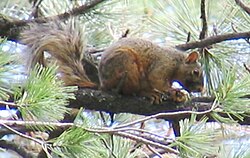 | S. nayaritensis
Allen, 1890
- S. n. apache (Apache fox squirrel)
- S. n. chiricahuae (Chiricahua fox squirrel)
- S. n. nayaritensis (Nayarit fox squirrel)
| Mexico and southern United States
 | Size: 25–26 cm (10 in) long, plus about 25 cm (10 in) tail [146]
Habitat: Forest [164]
Diet: Nuts, seeds, fruit, buds, and tree shoots [148] | LC
Unknown  [164] [164]
|
|---|
| Mexican gray squirrel  | S. aureogaster
F. Cuvier, 1829
- S. a. aureogaster
- S. a. nigrescens
| Mexico and Guatemala
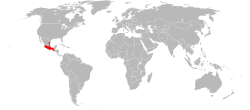 | Size: 23–31 cm (9–12 in) long, plus 21–28 cm (8–11 in) tail [146]
Habitat: Forest [165]
Diet: Nuts, seeds, fruit, buds, and tree shoots [148] | LC
Unknown  [165] [165]
|
|---|
| Northern Amazon red squirrel 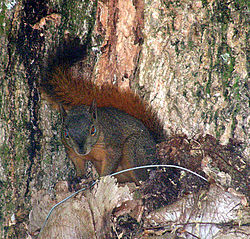 | S. igniventris
Wagner, 1842
- S. i. cocalis
- S. i. igniventris
| Northwestern South America | Size: 24–29 cm (9–11 in) long, plus 24–29 cm (9–11 in) tail [97]
Habitat: Forest [166]
Diet: Nuts, seeds, fruit, buds, and tree shoots [148] | LC
Unknown  [166] [166]
|
|---|
| Peters's squirrel
| S. oculatus
Peters, 1863
- S. o. oculatus
- S. o. shawi
- S. o. tolucae
| Central Mexico
 | Size: 51–56 cm (20–22 in) long, plus 26–27 cm (10–11 in) tail [146]
Habitat: Forest
Diet: Nuts, seeds, fruit, buds, and tree shoots [148] | LC
Unknown 
|
|---|
| Red squirrel 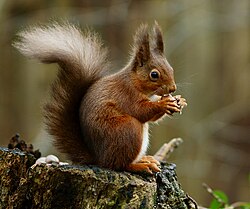 | S. vulgaris
Linnaeus, 1758
- S. v. alpinus
- S. v. altaicus (Altai red squirrel)
- S. v. anadyrensis (Anadyr red squirrel)
- S. v. arcticus (Arcticai red squirrel)
- S. v. balcanicus (Balkan red squirrel)
- S. v. chiliensis
- S. v. cinerea
- S. v. dulkeiti
- S. v. exalbidus (Siberian red squirrel)
- S. v. fedjushini
- S. v. formosovi (Formosov's red squirrel)
- S. v. fuscoater (Central European red squirrel)
- S. v. fusconigricans (Transbaikal red squirrel)
- S. v. leucourus (British red squirrel)
- S. v. lilaeus
- S. v. mantchuricus (Manchurian red squirrel)
- S. v. martensi (West Siberian red squirrel)
- S. v. ognevi (Central Russian red squirrel)
- S. v. orientis (Japanese red squirrel)
- S. v. rupestris (Sakhalin red squirrel)
- S. v. ukrainicus (Ukrainian red squirrel)
- S. v. varius (Kola red squirrel)
- S. v. vulgaris (Scandinavian red squirrel)
| Europe and Asia
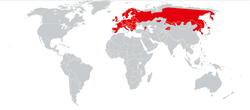 | Size: 21–25 cm (8–10 in) long, plus 15–20 cm (6–8 in) tail [146]
Habitat: Forest [168]
Diet: Nuts, seeds, fruit, buds, and tree shoots [148] | LC
Unknown  [168] [168]
|
|---|
| Red-tailed squirrel  | S. granatensis
(Humboldt, 1811)
- S. g. agricolae
- S. g. bondae
- S. g. candelensis
- S. g. carchensis
- S. g. chapmani
- S. g. chiriquensis
- S. g. chrysuros
- S. g. ferminae
- S. g. gerrardi
- S. g. granatensis
- S. g. griseimembra
- S. g. griseogena
- S. g. hoffmanni
- S. g. imbaburae
- S. g. llanensis
- S. g. manavi
- S. g. maracaibensis
- S. g. meridensis
- S. g. morulus
- S. g. nesaeus
- S. g. norosiensis
- S. g. perijae
- S. g. quindianus
- S. g. saltuensis
- S. g. soederstroemi
- S. g. splendidus
- S. g. sumaco
- S. g. tarrae
- S. g. valdiviae
- S. g. variabilis
- S. g. versicolor
- S. g. zuliae
| Northwestern South America and Central America
 | Size: 20–28 cm (8–11 in) long, plus 14–28 cm (6–11 in) tail [97]
Habitat: Forest [169]
Diet: Nuts, seeds, fruit, buds, and tree shoots [148] | LC
Unknown  [169] [169]
|
|---|
| Richmond's squirrel
| S. richmondi
Nelson, 1898 | Nicaragua
 | Size: 16–22 cm (6–9 in) long, plus 13–19 cm (5–7 in) tail [146]
Habitat: Forest [170]
Diet: Nuts, seeds, fruit, buds, and tree shoots [148] | NT
Unknown  [170] [170]
|
|---|
| Sanborn's squirrel
| S. sanborni
Osgood, 1944 | Peru and Bolivia | Size: 15–18 cm (6–7 in) long, plus 16–19 cm (6–7 in) tail [97]
Habitat: Forest [171]
Diet: Nuts, seeds, fruit, buds, and tree shoots [148] | DD
Unknown  [171] [171]
|
|---|
| Southern Amazon red squirrel  | S. spadiceus
Olfers, 1818
- S. s. spadiceus
- S. s. steinbachi
- S. s. tricolor
| Northwestern South America | Size: 24–29 cm (9–11 in) long, plus 23–34 cm (9–13 in) tail [97]
Habitat: Forest [172]
Diet: Nuts, seeds, fruit, buds, and tree shoots [148] | LC
Unknown  [172] [172]
|
|---|
| Variegated squirrel  | S. variegatoides
Ogilby, 1839
- S. v. adolphei
- S. v. atrirufus
- S. v. bangsi
- S. v. belti
- S. v. boothiae
- S. v. dorsalis
- S. v. goldmani
- S. v. helveolus
- S. v. loweryi
- S. v. managuensis
- S. v. melania
- S. v. rigidus
- S. v. thomasi
- S. v. underwoodi
- S. v. variegatoides
| Southern Mexico and Central America
 | Size: About 26 cm (10 in) long, plus 26–28 cm (10–11 in) tail [146]
Habitat: Forest [173]
Diet: Nuts, seeds, fruit, buds, and tree shoots [148] | LC
Unknown  [173] [173]
|
|---|
| Western gray squirrel 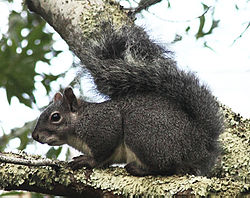 | S. griseus
Ord, 1818
- S. g. anthonyi
- S. g. griseus
- S. g. nigripes
| Western United States and western Mexico
 | Size: 26–32 cm (10–13 in) long, plus 24–31 cm (9–12 in) tail [146]
Habitat: Forest [174]
Diet: Nuts, seeds, fruit, buds, and tree shoots [148] | LC
Unknown  [174] [174]
|
|---|
| Yellow-throated squirrel
| S. gilvigularis
Wagner, 1842
- S. g. gilvigularis
- S. g. paraensis
| Northern South America
 | Size: 15–18 cm (6–7 in) long, plus 16–20 cm (6–8 in) tail [97]
Habitat: Forest [175]
Diet: Nuts, seeds, fruit, buds, and tree shoots [148] | DD
Unknown  [175] [175]
|
|---|
| Yucatan squirrel 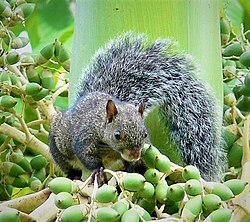 | S. yucatanensis
Allen, 1877
- S. y. baliolus
- S. y. phaeopus
- S. y. yucatanensis
| Southern Mexico and Central America
 | Size: 20–32 cm (8–13 in) long, plus 19–27 cm (7–11 in) tail [146]
Habitat: Forest [176]
Diet: Nuts, seeds, fruit, buds, and tree shoots [148] | LC
Unknown  [176] [176]
|
|---|

















































































